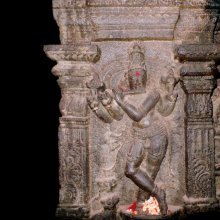Sudarshanacakra, Sudarśanacakra: 4 definitions
Introduction:
Sudarshanacakra means something in Hinduism, Sanskrit. If you want to know the exact meaning, history, etymology or English translation of this term then check out the descriptions on this page. Add your comment or reference to a book if you want to contribute to this summary article.
The Sanskrit term Sudarśanacakra can be transliterated into English as Sudarsanacakra or Sudarshanacakra, using the IAST transliteration scheme (?).
Alternative spellings of this word include Sudarshanachakra.
Images (photo gallery)
In Hinduism
Vaishnavism (Vaishava dharma)
Source: Pure Bhakti: Bhagavad-gita (4th edition)Sudarśanacakra (सुदर्शनचक्र) refers to “invincible disc weapon of Śrī Bhagavān”. (cf. Glossary page from Śrīmad-Bhagavad-Gītā).
Source: Pure Bhakti: Brhad BhagavatamrtamSudarśanacakra (सुदर्शनचक्र) refers to:—The disc weapon of Viṣṇu. (cf. Glossary page from Śrī Bṛhad-bhāgavatāmṛta).

Vaishnava (वैष्णव, vaiṣṇava) or vaishnavism (vaiṣṇavism) represents a tradition of Hinduism worshipping Vishnu as the supreme Lord. Similar to the Shaktism and Shaivism traditions, Vaishnavism also developed as an individual movement, famous for its exposition of the dashavatara (‘ten avatars of Vishnu’).
Purana and Itihasa (epic history)
Source: Shodhganga: The saurapurana - a critical studySudarśanacakra (सुदर्शनचक्र) or simply Sudarśana refers to Śiva’s discus (cakra), and is mentioned in the 10th century Saurapurāṇa: one of the various Upapurāṇas depicting Śaivism.—The origin of Sudarśanacakra is related in the Saurapurāṇa 37.14ff in connection with the killing of Jalandhara.—The myth of receiving the Sudarśanacakra by Viṣṇu is related in the forty first chapter of the Saurapurāṇa. As the story goes there was a severe fight between the gods and the demons in which the gods were lamentably defeated and they sought the help of Viṣṇu. The gods prayed him to kill the Asuras by Sudarśanacakra which was previously received from Śiva for killing the demon Jalandhara. [...]

The Purana (पुराण, purāṇas) refers to Sanskrit literature preserving ancient India’s vast cultural history, including historical legends, religious ceremonies, various arts and sciences. The eighteen mahapuranas total over 400,000 shlokas (metrical couplets) and date to at least several centuries BCE.
Languages of India and abroad
Sanskrit dictionary
Source: Cologne Digital Sanskrit Dictionaries: Aufrecht Catalogus Catalogorum1) Sudarśanacakra (सुदर्शनचक्र) as mentioned in Aufrecht’s Catalogus Catalogorum:—from the Rudrayāmala. Stein 236.
2) Sudarśanacakra (सुदर्शनचक्र):—jy. Ulwar 2015.
Source: Cologne Digital Sanskrit Dictionaries: Monier-Williams Sanskrit-English DictionarySudarśanacakra (सुदर्शनचक्र):—[=su-darśana-cakra] [from su-darśana > su > su-tanaya] n. Viṣṇu’s discus, [Catalogue(s)]
Sanskrit, also spelled संस्कृतम् (saṃskṛtam), is an ancient language of India commonly seen as the grandmother of the Indo-European language family (even English!). Closely allied with Prakrit and Pali, Sanskrit is more exhaustive in both grammar and terms and has the most extensive collection of literature in the world, greatly surpassing its sister-languages Greek and Latin.
See also (Relevant definitions)
Partial matches: Sudarshana, Cakra.
Starts with: Sudarshanacakravartin.
Ends with: Mahasudarshanacakra.
Full-text: Sudarshana, Cakra, Cakravan, Nilacala, Niladri, Dandapani, Durdama, Nimbarka, Kavyamata, Barbarika, Rudrayamalatantra.
Relevant text
Search found 20 books and stories containing Sudarshanacakra, Sudarśanacakra, Sudarsanacakra, Sudarshana-cakra, Sudarśana-cakra, Sudarsana-cakra; (plurals include: Sudarshanacakras, Sudarśanacakras, Sudarsanacakras, cakras). You can also click to the full overview containing English textual excerpts. Below are direct links for the most relevant articles:
Song 14 < [Bhakta-gaṇa-saha-vihāra (Pastimes with the Devotees)]
Song 6 < [Bālya-līlā (Ages 1-5—Pastimes)]
Song 5 < [Grantharambha (the book begins)]
Chaitanya Bhagavata (by Bhumipati Dāsa)
Verse 3.2.330-333 < [Chapter 2 - Description of the Lord’s Travel Through Bhuvaneśvara and Other Placesto Jagannātha Purī]
Verse 3.2.319 < [Chapter 2 - Description of the Lord’s Travel Through Bhuvaneśvara and Other Placesto Jagannātha Purī]
Verse 2.13.183-189 < [Chapter 13 - The Deliverance of Jagāi and Mādhāi]
Brihad Bhagavatamrita (commentary) (by Śrī Śrīmad Bhaktivedānta Nārāyana Gosvāmī Mahārāja)
Verse 2.4.71 < [Chapter 4 - Vaikuṇṭha (the spiritual world)]
Verse 2.1.219 < [Chapter 1 - Vairāgya (renunciation)]
Verse 1.3.15 < [Chapter 3 - Prapañcātīta (beyond the Material Plane)]
Garga Samhita (English) (by Danavir Goswami)
Verse 6.21.4 < [Chapter 21 - In the Description of the Third Fort, the Glories of Piṇḍāraka-tīrtha]
Verse 3.2.20 < [Chapter 2 - The Great Festival of Śrī Girirāja]
Verse 6.10.21 < [Chapter 10 - In the Description of the Gomatī River, the Glories of Cakra-tīrtha]
Puranic encyclopaedia (by Vettam Mani)
Srila Gurudeva (The Supreme Treasure) (by Swami Bhaktivedanta Madhava Maharaja)
A visit from Parents < [Chapter 1.6 - Return to Maṭha Life]
Related products


